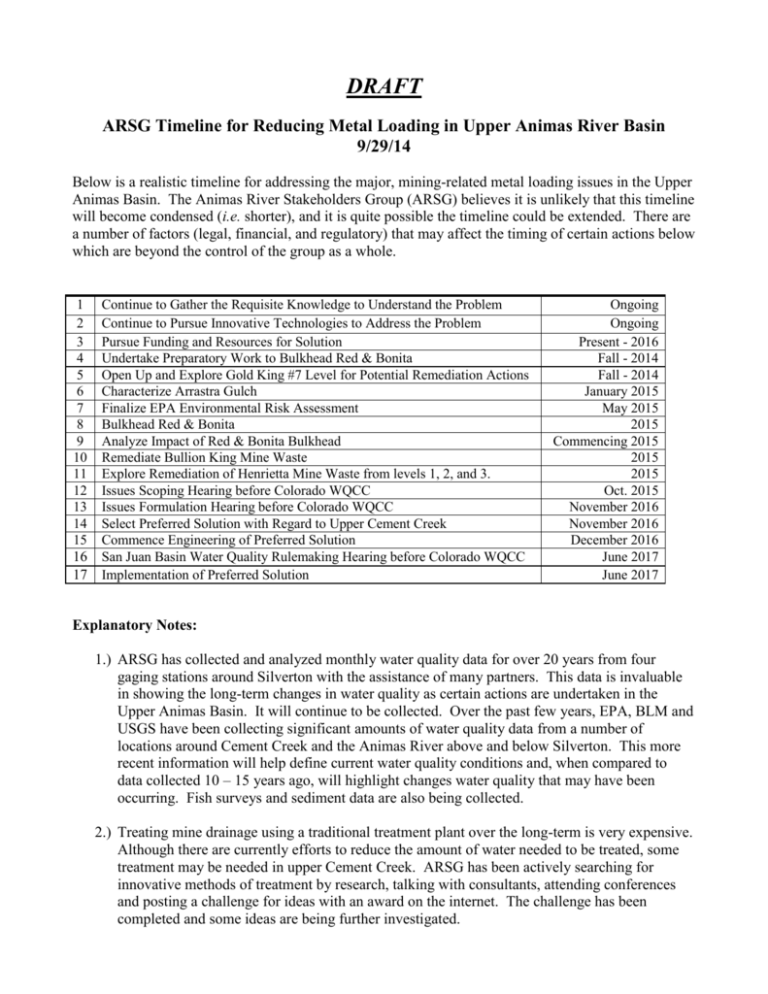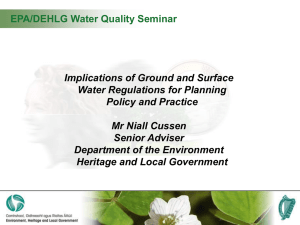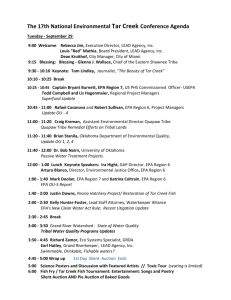View Draft of Timeline for Reducing Metal Loading in Upper Animas
advertisement

DRAFT ARSG Timeline for Reducing Metal Loading in Upper Animas River Basin 9/29/14 Below is a realistic timeline for addressing the major, mining-related metal loading issues in the Upper Animas Basin. The Animas River Stakeholders Group (ARSG) believes it is unlikely that this timeline will become condensed (i.e. shorter), and it is quite possible the timeline could be extended. There are a number of factors (legal, financial, and regulatory) that may affect the timing of certain actions below which are beyond the control of the group as a whole. 1 2 3 4 5 6 7 8 9 10 11 12 13 14 15 16 17 Continue to Gather the Requisite Knowledge to Understand the Problem Continue to Pursue Innovative Technologies to Address the Problem Pursue Funding and Resources for Solution Undertake Preparatory Work to Bulkhead Red & Bonita Open Up and Explore Gold King #7 Level for Potential Remediation Actions Characterize Arrastra Gulch Finalize EPA Environmental Risk Assessment Bulkhead Red & Bonita Analyze Impact of Red & Bonita Bulkhead Remediate Bullion King Mine Waste Explore Remediation of Henrietta Mine Waste from levels 1, 2, and 3. Issues Scoping Hearing before Colorado WQCC Issues Formulation Hearing before Colorado WQCC Select Preferred Solution with Regard to Upper Cement Creek Commence Engineering of Preferred Solution San Juan Basin Water Quality Rulemaking Hearing before Colorado WQCC Implementation of Preferred Solution Ongoing Ongoing Present - 2016 Fall - 2014 Fall - 2014 January 2015 May 2015 2015 Commencing 2015 2015 2015 Oct. 2015 November 2016 November 2016 December 2016 June 2017 June 2017 Explanatory Notes: 1.) ARSG has collected and analyzed monthly water quality data for over 20 years from four gaging stations around Silverton with the assistance of many partners. This data is invaluable in showing the long-term changes in water quality as certain actions are undertaken in the Upper Animas Basin. It will continue to be collected. Over the past few years, EPA, BLM and USGS have been collecting significant amounts of water quality data from a number of locations around Cement Creek and the Animas River above and below Silverton. This more recent information will help define current water quality conditions and, when compared to data collected 10 – 15 years ago, will highlight changes water quality that may have been occurring. Fish surveys and sediment data are also being collected. 2.) Treating mine drainage using a traditional treatment plant over the long-term is very expensive. Although there are currently efforts to reduce the amount of water needed to be treated, some treatment may be needed in upper Cement Creek. ARSG has been actively searching for innovative methods of treatment by research, talking with consultants, attending conferences and posting a challenge for ideas with an award on the internet. The challenge has been completed and some ideas are being further investigated. 3.) There are several sources for funding. Sunnyside Gold Corp. (SGC) has offered $6.5 million towards a solution, contingent on an agreement with regulatory agencies that SGC will have no other future liabilities in the basin. By the time any preferred solution is implemented, with interest, the $6.5 million will have grown to $10 million. Also, there is $4 million set aside in a trust to offset liabilities from ASARCO activities in San Juan County. In addition, EPA and BLM have dedicated significant resources towards investigative efforts towards a solution. EPA has committed to funding the opening of both the Red & Bonita and Gold King mines and bulkheading the Red & Bonita. Additional funds could be available if locations in the basin are determined to be eligible and are designated for the National Priority List under CERCLA, although without an agreement SGC would not voluntarily provide the $10 million. 4.) In 2012, EPA opened up the Red & Bonita mine for investigations. The mine discharges approximately 300 gpm of highly contaminated water and is one of the two biggest miningrelated sources of metals in the basin. In 2013, EPA along with the Colo. Division of Reclamation, Mining and Safety (DRMS) thoroughly explored the accessible workings. For fall of 2014, EPA is planning on packer testing in locations thought to be suitable for bulkheading to determine hydraulic conductivity. 5.) EPA has entered into an agreement with the property owner of the Gold King to open up the collapsed portal at the #7 level to investigate the workings in fall of 2014. Mine drainage from the Gold King varies greatly depending on the time of year. At certain times, it is the biggest single mining-related source of metals in the basin. Underground investigation hopefully will help determine the locations of water infiltration and if anything can be done to prevent it. 6.) ARSG is working on a report characterizing water quality and the impacts from historic mining in Arrastra Gulch. Much of the characterization work was done ten years ago, and this effort will document if anything has changed. The report will provide some of the information for making decisions related to the use of the trust money related to the ASARCO settlement. 7.) Over the past couple of years, EPA and BLM have put substantial resources into developing an environmental risk assessment of the impacts to the Animas Basin caused by past mining activities. While the main focus has been on impacts to aquatic life through water quality and potentially contaminated sediments, there will be some efforts to assess potential impacts to terrestrial life. The assessment is a necessary step in designating a potential CERCLA site. The assessment is meant to be a component in setting water quality goals. 8.) EPA is planning to install a concrete bulkhead in the Red & Bonita in 2015 to greatly reduce the water flow from the mine. 9.) There is an expectation that a bulkhead in the Red & Bonita will not reduce the loading from that adit one hundred percent. There may be leakage in the workings around the bulkhead and/or water may find other drainage paths through fracture zones. However, if a bulkhead reduces metal loading by only 40-50% percent, it would probably still be cost-effective when compared to the cost of conventional AMD treatment. All parties are interested in identifying and monitoring locations where additional metal loading may occur as a result of the bulkhead. 10.) The Bullion King mine waste is the last mine waste site in Mineral Creek which was identified by ARSG for remediation that has not been remediated. Funding for the project will come from the 319 non-point source program. Overall, a variety of remediation projects in the Mineral Creek drainage over almost twenty years have reduced low-flow concentrations of zinc by 50% and copper by 70%. 11.) In 2000, ARSG identified 32 mine waste sites in the whole basin that would be desirable to remediate. Most of those sites of have been completed. One remaining site is the Henrietta levels 1, 2, and 3 in Prospect Gulch. ARSG will hopefully hear this fall if funding for remediation is available. 12.) This is a short hearing before the Colorado Water Quality Control Commission to identify issues that may come up in the June 2017 San Juan Rulemaking Hearing. 13.) This hearing is used to identify proposals that will be addressed in the WQCC June 2017 San Juan Rulemaking Hearing. 14.) Because of a large amount of metal loading over the last ten years from four draining adits in upper Cement Creek, ARSG’s key focus is on developing potential solutions for managing this loading. A number of steps in identifying solutions are underway. They include: opening up and exploring the Red & Bonita and the Gold King, bulkheading the Red & Bonita and monitoring the hydrologic system response, and researching and testing less expensive methods of water treatment. Hopefully these steps and others will lead to a preferred solution for the metal loading. In addition, EPA is doing more investigations of the Animas River drainage above Silverton, beyond work previously done by ARSG, to see if other remediation efforts could cost-effectively reduce metal loading from this drainage. 15.) Start engineering on preferred solution identified above. 16.) This rulemaking hearing is an opportunity to propose possible changes to the water quality standards in the Animas River Basin. 17.) Begin implementing the preferred solution. To give a base case scenario with which to compare various solutions in Cement Creek, SGC has made the following estimates Assuming the availability of only $10M ("Base Case”), SGC estimates that a 300 gpm lime treatment plant could be built for approximately $4M, leaving approximately $6M for O&M. (Utilizing a 7% discount rate, this would allow the plant to run for around 20 years.) SGC estimates that with the Base Case plant treating Cement Creek water fairly near Gladstone would reduce low flow Zn levels at CC-48 and A-72 respectively by approximately 41% and 18%. Two other examples: 1) SGC estimates that treating the water directly from the major adits with a 300 gpm plant would reduce low flow Zn levels at CC48 and A-72 respectively by approximately 67% and 34%; and 2) SGC estimates that a 1,000 gpm plant ($15M combined Capital and Operating expenses) treating Cement Creek water fairly near Gladstone would reduce low flow Zn levels at CC-48 and A72 respectively by approximately 81 % and 34%.







